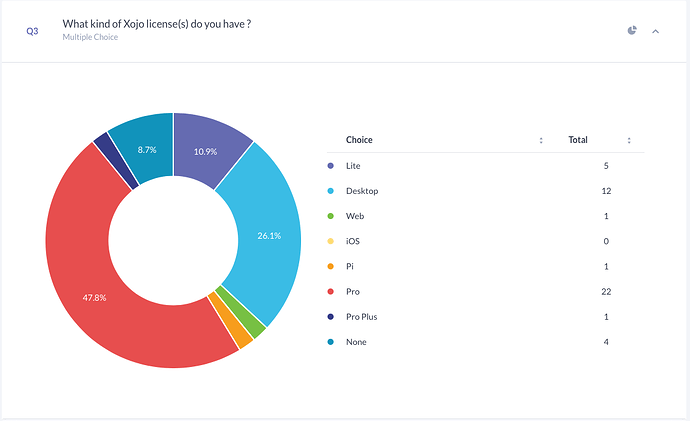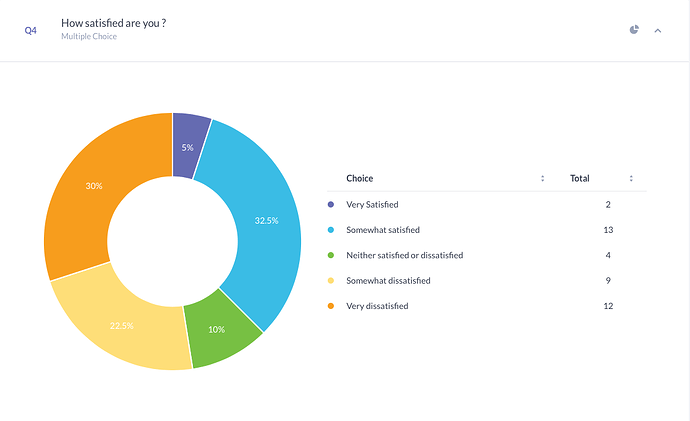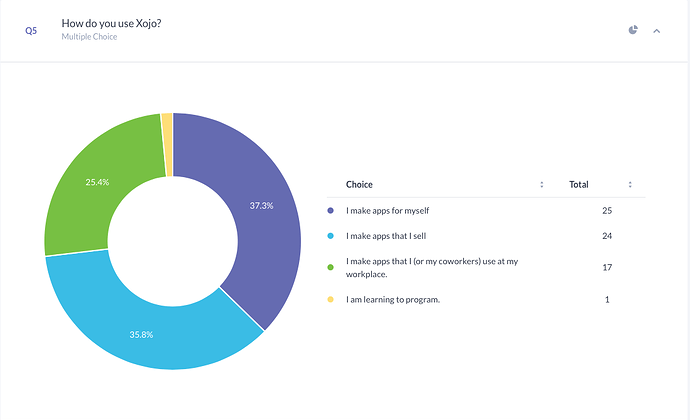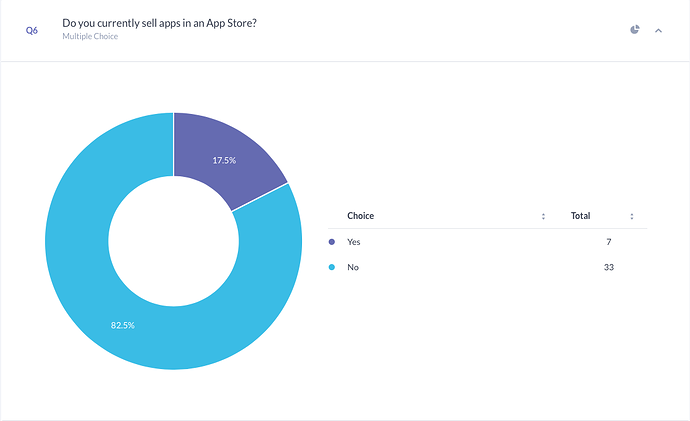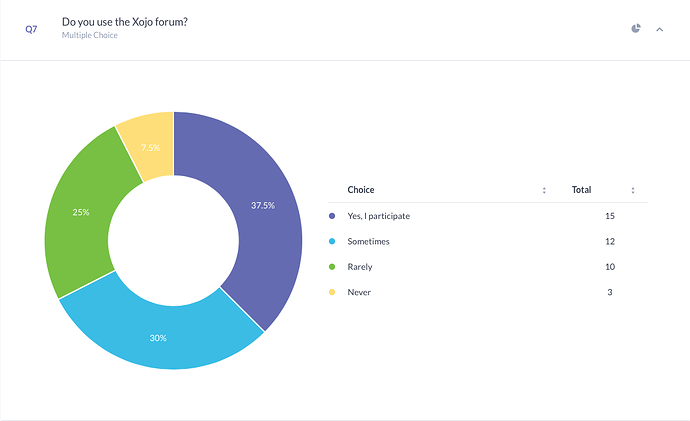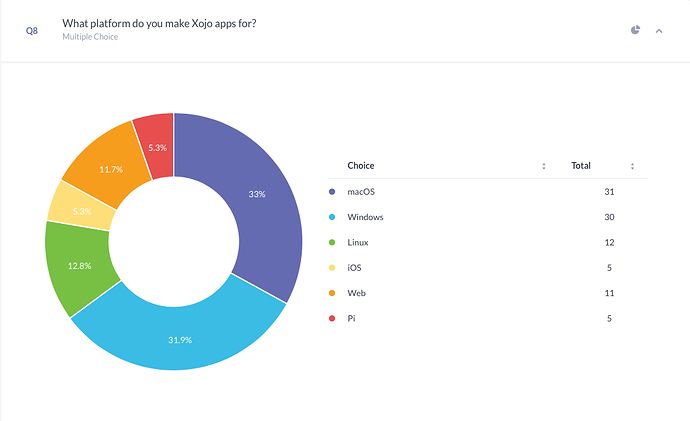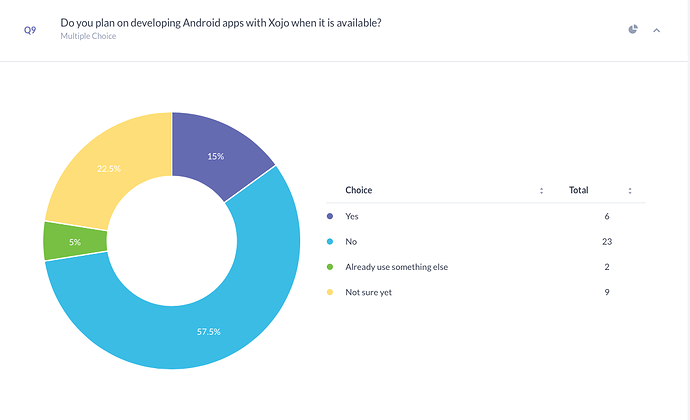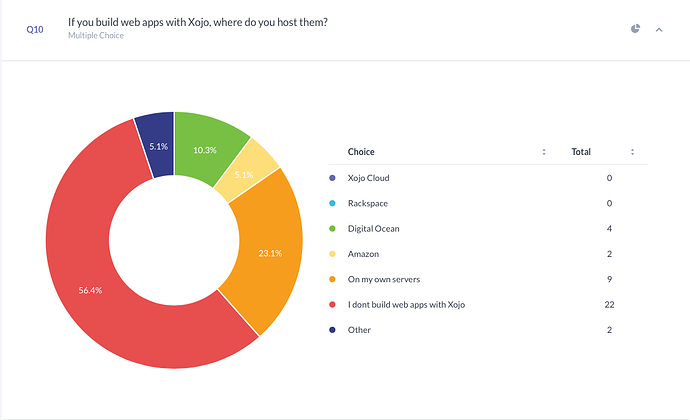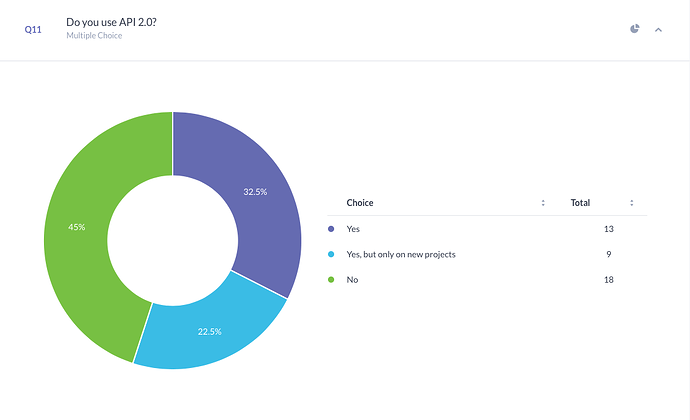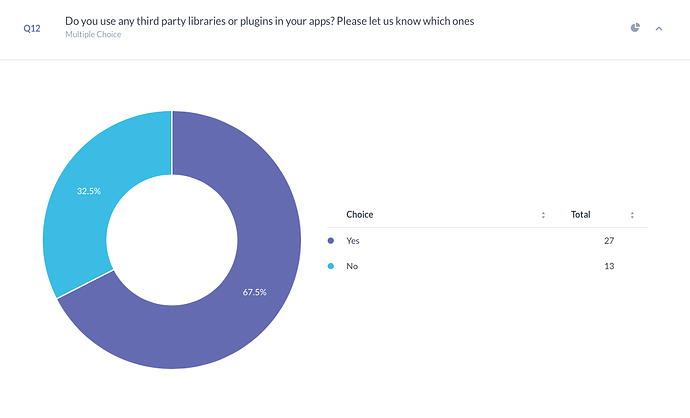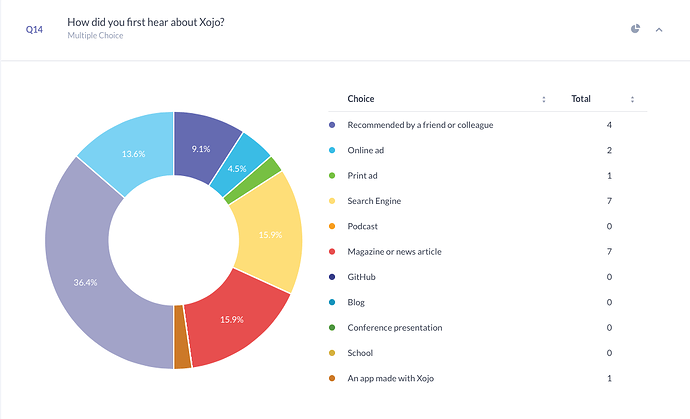I realize readers here might be biased (a bit)
Multiple years into API 2 and all the rest of the changes I’m curious
Some readers might be a biased…
…may have had a bad experience with Xojo.
Why do you use the version(s) you do ?
- It’s the most recent one and I need to keep good OS compatibility.
- evaluate for future project
- In order to see if bug fixes work out for me
- API compatibility
- 2018r4: Development newer ones: Build only
- It has the features I need for my own projects. The newer versions don’t offer me anything I need and don’t already have so I see no reason to spend the money to get more recent versions.
- The latest version for newer projects. 2022r1 to maintain an old project (major) project. I haven’t tested the 200+ features in 2022r4 yet 2019r3 to maintain an old web project. But it is currently being converted to 2022r4
- 2021r3 is the last version where a few things required by my years-old projects still work backward-compatible with older versions, including 2012r2
- Expensive
- I have old programs that are too laborious to convert to the latest version, so I use 2019R11 for them. For those that I have converted to work with the latest version, I use the latest version.
- I upgrade to conform with the companies best advice and current direction.
- Easier and better to stay up to date rather than fall behind. Also the latest bug fixes can only be found in the current version.
- It’s stable for what I need (xplat desktop, mostly Windows), and I don’t want to mess with changes or regressions.
- Support for some legacy apps using API1
- compatibility with latest systems. moved on recently from 2019r11.
- Most complete Xojo web 2 implementation
- a few things got fixed that we needed.
- I decide NOT to renew in 2022
- Latest release, which I assume has the most bug fixes
- Maintain an older Xojo based app and also create small utils for personal use.
- Latest version my expired Pro license supports, plus it’s pre-Desktop* controls. Have a current desktop-only license just for building Mac apps.
- Most current version.
- Just started using the platform this year so am not burdened with legacy applications to maintain.
- I stay current.
- To learn Xojo using more available resources for learning.
- 2017
- Purely to maintain a couple of applications that have not yet been converted using either Purebasic or Livecode.
- Because syntax changes and API2.0 added a layer of uselessness after 2019r1.1
- No DesktopControls
- 2022 versions to cover desktop, 2019 to cover web 1 apps.
- One is for API1 and the other is for API2
- I prefer the way Realstudio presented things. Each class/module in its own tab, a pinned project tab that gave an overview of everything. And I hate the way the method signature editor got squished into the right side panel.
- Not want to update my code toAPI2 or relearn a language I have ben using over 20 years
- because i need it
- Last stable API 2.0 release; Last stable Web 1.0 release
- Don‘t use Xojo anymore. Too many bugs, too many errors and omissions in documentation.
Why do you use additional libraries ?
-
Because of all the missing platform features not available in pure Xojo (MBS, Einhugur)
-
Missing functionality
-
They provide what Xojo doesn’t.
-
Other than what came with Xojo (or the OS), I use no extra libraries.
-
For additional features.
-
yes, e.g. libcrypto, libz, and self-written ones, all thru declares
-
To add features that Xojo does not offer.
-
Bridges the gap in Xojo and framework deficiencies.
-
I don’t, although I converted the source for a PDF library (vbPDF) from VB to Xojo, so it’s kind of like using a library. But I’m the only user and I maintain it. LOL I don’t want to rely on third parties to update things, many aren’t reliable about it. And with all the Xojo changes, I definitely can’t trust that something will always work.
-
Native network stack is horribly slow.
-
I hate them.
-
I do not use additional libraries
-
To quickly and easily do things that are not built-in to Xojo
-
need the features available on the plugins
-
Xojo does not have the core capabilities required for anything beyond basic functionality, so MBS is generally required to do anything more complex. There are some more things I wish Xojo did out of the box, but when it comes to desktop, I think it has a good balance of functionality and I don’t mind adding plugins to increase that. What it does for desktop out of the box is fine for a lot of use cases in my opinion. This cannot be said for iOS, which is an expensive toy.
-
Need features Xojo doesn’t have.
-
Missing features in Xojo.
-
Only when i absolutely must. Over time I would expect that the abandonware and lack of timely support or fixes within the Xojo framework and products would force my hand. I have already bought the MBS SQL plugins.
-
Xojo limits the available functions to what all supported platforms have in common.
-
mbs
-
missing functionality
-
MBS plugins to fill the Xojo gaps.
-
I don’t.
-
MBS and Einhugur
-
Additional libraries are needed since Xojo does not provide the functionality
-
Several Einhugur DynaPDF ChartDirector
-
mbs eingh
-
Einhugur, MBS
-
Fill in the gaps and bugs.
What are the top 3 features you’d like to see in Xojo? Please provide a case number, or url, if applicable.
-
Native threads and background compatibility. A modern and fast IDE and not that buggy lame example of bad design it currently is. A CEO whose visions give me the idea Xojo will live anther 25 years, who listens to the user base and who does not alienate the Pro customers by concentrating on newbies.
-
Proper support for choosing which framework you want to use, including code completion, filtering help topics and optional warnings on a per module basis, including warnings about possible integration issues.
-
Long term support and product roadmap, command line compiler, API migration
-
Support/Fixes of API 1 issues Count that 3x

-
Since I only write apps for myself and already have the features I regularly need, I really can’t answer this.
-
A working Android version Widgetkit support for iOS Xojo: Account Login True multi core threads, for all targets. Xojo: Account Login
-
- Web app - handle ALL urls - xojo as full php replacement 2. Web app - optionally disable executing web browser after compile and run web project 3. Web app - handle request using multi cpu core 4. Better ide project navigator - ex. items without group subtitles
-
I think I no longer care.
-
Desktop charting Enhanced pdf creation More stable, consistent and intuitive language structure
-
Bug fixes, bug fixes and Desktop control additions/enhancements.
-
Better Windows support. Take bug fixes seriously. Better documentation.
-
Multi-core support, command line compiler
-
- Full Bootstrap suite of controls (Web 2) 2) Better abstraction from CSS/JavaScript inner workings (Web 2) 3) Easier SQLite integration with controls
-
Generics Better concurrency More controls
-
fix all the bugs for the window and Mac desktop
-
Grid control Modern Windows UI Websocket support
-
Honestly, I’ve given up on Xojo for anything serious after the API 2 and new control fiasco, but what the answer would have been if I hadn’t moved wholesale to Swift is: 1. More functionality in iOS. The lack of basic functions and controls is very poor, making it unusable for anything beyond basic toys. I looked at it for my current app, but it’s nowhere near good enough, especially for the cost. 2. Media pickers in iOS to allow access to the Music library. 3. Better native MacOS controls, like the toolbar, list box etc. Aklso modern UI layouts and effects (like translucency - it’s been around for years already). It’s hard to create an app that looks modern with Xojo.
-
- Bug fixes - Grid control - Better iOS support (gestures, more controls, better customization of controls, …)
-
Much better documentation and documentation searchability True threading A better debugger, particularly the ability to define watch expressions and/or see the values of variables by hovering the cursor over code references.
-
Listening to users’ needs. Networking in Android. Basic fixes in the framework.
-
Plugins made with Xojo
-
drop everything but desktop, focus on being rock solid desktop only
-
- better windows UI compatability Oh well, I dont use it that much anymore, so I really dont care

- better windows UI compatability Oh well, I dont use it that much anymore, so I really dont care
-
I’ve past caring about Xojo and have moved on.
-
A responsive CEO
-
Tighter integration with the OS. Optimized frameworks, so apps aren’t so fat. More focus on things developers actually need.
-
Preemptive threads, a bunch of language improvements, a better IDE.
-
Multi core threading Vulkan Better help system
-
An in-process alternative to Workers (in other words, preemptive threads.) https://tracker.xojo.com/xojoinc/xojo/-/issues/71681 The ability to turn TLS on after the connection is established in the SSLSocket. https://tracker.xojo.com/xojoinc/xojo/-/issues/49500 #pragma X86CallingConvention FastCall
-
Reliability Reliability Reliability
-
fastest way known to men to build mac and windows app, with plenty of features
-
Bugfixes, Usable Web 2.0, Usable IDE code editor
Are there any bugs that are causing regular issues for you? Please provide case numbers or urls
-
Nope. The writing is clearly on the wall, I am tired of writing tickets that will get addressed in maybe 10 years. The main bug is the company’s heading, stubbornly driving out old pro users and the development team being undermanned extremely.
-
Keyup/down events: KeyDown event - distinguish special keys from typed characters - General - Xojo Programming Forum Window positioning: Xojo: Account Login
-
Not at this time.
-
I think I no longer care about that eihther.
-
I’ve found workarounds for everything important, and don’t even know if the original bugs are still there. I found reporting bugs wasn’t too helpful.
-
None I can’t work around so far
-
having problem with resizing images which used to work find in Xojo 2014 but since then it create pretty bad and pixelated thumbnail on Window version
-
No, I’ve worked around the ones that are issues.
-
I haven;'t used Xojo in anger for anything serious for a year now, so I am not up to speed with what’s been fixed. I only use it for serious development to maintain a couple of older apps, so any bugs would be in API 1, which I’m sure won’t be touched anyway. So why waste my time listing them? These apps will be transitioned to Swift soon.
-
I stopped filing bug reports, because to many remain unfixed. Currently coding around bugs.
-
There are a lot of minor issues in the IDE and the compiler that add up to frustration but since I’ve figured out there’s no point in writing up a bug only for it to languish unaddressed for years and then be closed, I understand that I have to live with them unless they are a show stopper for everyone.
-
Yes, but searching for them would take ages.
-
Not anymore.
-
graphics bugs random crashes
-
Have not been using it much in he last year so I can’t name the specifics ones at the moment
-
nope
-
Not a specific bug but tired of work around.
If you have recommended Xojo to someone else, how did you describe it?
-
I loved to do that in the past and on several occasions, but I would not do that today. I lost hope in Xojo’s course.
-
a brilliant product
-
VisualBasic-like cross-platform RAD
-
Desktop x Platform (without fancy new OS features) - ok
-
N/A
-
Easy to learn, simple to use, cross platform. One tool = one knownleadge. A little bit expensive for Pro version.
-
I haven’t recommended Xojo to anyone.
-
Native-ish cross-platform desktop development with some caveats.
-
I used to describe it as a great replacement for Visual Basic. I don’t recommend it any more.
-
I haven’t recommended it to anyone as I generally don’t have programmer friends
-
I haven’t recommended Xojo in maybe 3 years. API2 really took the sails out of my enthusiasm for Xojo
-
don’t think I would do that
-
No. I can’t recommend it. The fact I’m still using it is a bit embarrassing.
-
I would not. It’s too much in flux at the moment. The only good thing I would say is that it’s fine for producing simple desktop apps, providing you don’t want them to look too flashy or modern. Finding working code examples these days is almost impossible since the change to API 2 and the new controls, so I wouldn’t recommend it to a new user.
-
Useful tool for beginners/hobbyists to learn programming simple apps.
-
Regrettably I can’t recommend it.
-
Build native apps for Mac, Windows, Linux, iOS and web, with a language which doesn’t use superfluous characters.
-
I recommended realbasic but never Xojo.
-
Not for a long time
-
Use Xojo for calculator type apps only
-
Have not recommended i since it was renamed to Xojo
-
fastest way to make a mac app
-
Hell, no!
-
Xojo used to be good but it’s too buggy to use.

